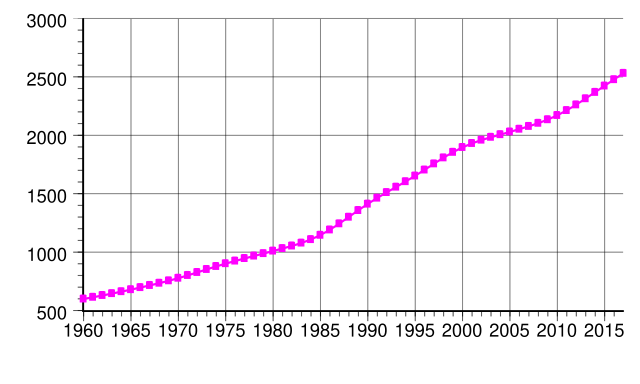Top Qs
Timeline
Chat
Perspective
Demographics of Namibia
From Wikipedia, the free encyclopedia
Remove ads
This is a demography of the population of Namibia including population density, ethnicity, education level, health of the populace, economic status, religious affiliations and other aspects of the population.
Remove ads
Population
Summarize
Perspective


Census results
As required by the Namibian Statistics Act #66 of 1976, and in accordance with United Nations recommendations, a census is conducted every ten years. After Namibian independence the first Population and Housing Census was carried out in 1991, further rounds followed in 2001 and 2011.[2] The data collection method is to count every person resident in Namibia wherever they happen to be. This is called the de facto method.[3] For enumeration purposes the country is demarcated into 4,042 enumeration areas. These areas overlap with constituency boundaries in order to get reliable data for election purposes as well.[4]
The 2011 Population and Housing Census counted 2,113,077 inhabitants of Namibia. Between 2001 and 2011 the annual population growth was 1.4%, down from 2.6% in the previous ten–year period.[5]
In 2011 the total fertility rate was 3.6 children per woman, down from 4.1 in 2001.
UN estimates
According to the 2022 revision of the World Population Prospects[6][7] the total population was 2,530,151 in 2021, compared to only 485 000 in 1950. The proportion of children below the age of 15 in 2010 was 36.4%, 59.9% was between 15 and 65 years of age, while 3.7% was 65 years or older .[8]
Population Estimates by Sex and Age Group (01.VII.2020) (Based on the results of the 2011 Population Census.):[9]
Remove ads
Vital statistics
Summarize
Perspective
United Nations estimates
Registration of vital events in Namibia is not complete. The website Our World in Data prepared the following estimates based on statistics from the Population Department of the United Nations.[10]
View source data.
View source data.
View source data.
View source data.
Demographic and Health Surveys
Total Fertility Rate (TFR) (followed by wanted fertility rate in brackets) and Crude Birth Rate (CBR):[11]
Fertility data as of 2013 (DHS Program):[12]
Life expectancy at birth
Life expectancy from 1950 to 2015 (UN World Population Prospects):[13]
Remove ads
Ethnic groups
Summarize
Perspective


Namibia has many ethnic groups. The majority of the Namibian population is of Bantu-speaking origin—mostly of the Ovambo ethnicity, which forms about half of the population—residing mainly in the north of the country, although many are now resident in towns throughout Namibia. They also include the Lozi people and Kavango people. Other ethnic groups are the Herero and Himba people, who speak a similar language, and the Damara, who speak the same "click" language as the Nama. As of 2022[update] Herero and Nama peoples make up less than 10% of the population, but at the beginning of the 20th century and before the Herero and Nama genocide, they made up a majority.[16]
The largest ten ethnic groups are Aakwanyama, Aandonga, Ovaherero, Damara, Aakwambi, Vakwangali, Nama, Aambalantu, Vakavango, and Aangandjera.[17]
In addition to the Bantu majority, there are large groups of San, who are descendants of the original culture of Southern Africa, as well as Nama who are descendants of the above as well as mixed with colonists. They often speak Khoekhoegowab. The country also contains some descendants of refugees from Angola.
There are also two smaller groups of people with mixed racial origins, called "Coloureds" (2,1%) and "Basters" (1,5%).[18] There is a substantial Chinese minority in Namibia; it stood at 40,000 in 2006.[19]
Whites (mainly of Afrikaner, German, British and Portuguese origin) make up 1,8% of the population, according to the 2023 Population and Housing Census.[20] Although their proportion of the population decreased after independence due to emigration and lower birth rates, they still form the second-largest population of European ancestry, both in terms of percentage and actual numbers, in Sub-Saharan Africa (after South Africa/Angola).[21] The majority of Namibian whites and nearly all those who are of mixed race, speak Afrikaans and share similar origins, culture, and religion as the white and coloured populations of South Africa. A large minority of whites (around 30,000) trace their family origins back to the German settlers who colonised Namibia prior to the British confiscation of German lands after World War I, and they maintain German cultural and educational institutions. Nearly all Portuguese settlers came to the country from the former Portuguese colony of Angola.[22] The 1960 census reported 526,004 persons in what was then South West Africa, including 73,464 whites (14%).[23]
Remove ads
Languages






Languages of Namibia in 2022.[24]
- Oshiwambo (48.9%)
- Khoekhoegowab (11.3%)
- Afrikaans (11.3%)
- Otjiherero (8.60%)
- RuKwangali (8.50%)
- Silozi (4.80%)
- English (3.40%)
- German (1.00%)
- Other (2.20%)
Remove ads
Religion
Missionary work during the 19th century drew many Namibians to Christianity, especially Lutheranism. While most Namibian Christians are Lutheran, there also are Roman Catholic, Methodist, Anglican, African Methodist Episcopal, and Dutch Reformed Christians represented.
- Christian 80% to 90% (at least 50% Lutheran)[24]
- Indigenous beliefs 10% to 20%
References
External links
Wikiwand - on
Seamless Wikipedia browsing. On steroids.
Remove ads

